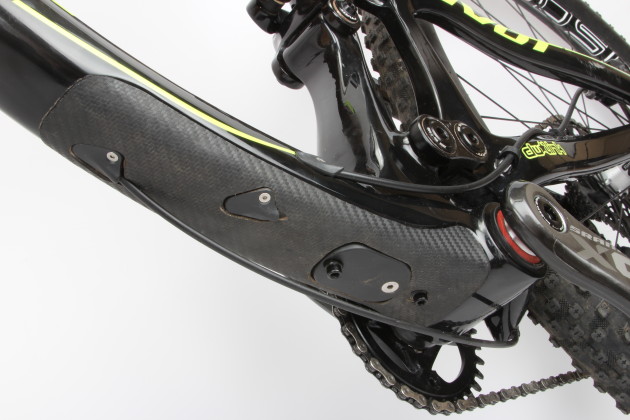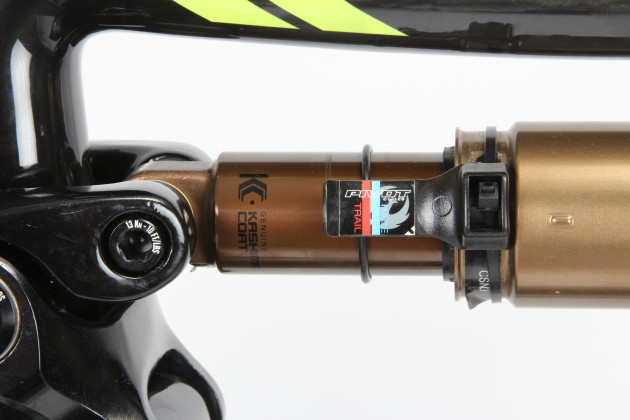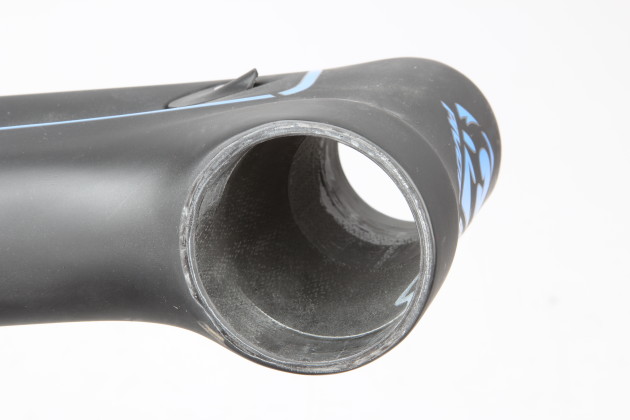Pivot Mach 4 Carbon
Back in 2007/08 when Chris Cocalis launched the Pivot brand, the Mach 4 was their key model and it remained in the line-up until 2014. Sure it received some updates along the way but up until last year it still sported 26-inch wheels, an alloy frame and 100mm of travel from the DW-Link suspension. As an XC bike with 26-inch wheels, its popularity took a serious dive later in its career but now Pivot has injected new life into the Mach 4.
The new Mach 4 features a carbon frame, 27.5-inch wheels and the travel has also grown with 115mm at the rear end, making it more of a Mach 4.5. While the travel is up, the bike is still pitched at the cross-country market with an emphasis on keeping the weight down.

Weight a Minute
Pivot claims it’s the lightest full suspension frame they’ve ever made at 2,300g, and that’s meant to include the Fox CTD shock. I think they must have weighed the XXS frame with a few bits missing to obtain this figure, as we weighed a couple of large Mach 4s and both came in at 2,500kg. This is light but not a real featherweight in XC racing terms, in fact the frame weighs almost as much as the 145mm travel Mach 5.7c that I used to own.
There’s a lot to the new Mach 4, with a multitude of internal cable routing options for both derailleurs as well as the rear brake hose, and it caters for regular and ‘stealth’ style dropper posts too. While internal cables look tidy I’m generally not a fan, preferring the serviceability of a traditional setup. In this case I welcomed the internal routing with open arms. Many Pivot models route the cables right next to the shock where they bow out and move around as the suspension cycles up and down—it looks messy and if you’re not careful the cables can rub on the shock or frame. This is a non-issue on the Mach 4 and it caters to a wide range of setups; there’s even an internal hiding spot for a Di2 battery in case you’re cashed up enough to run the latest electronic XTR drivetrain from Shimano.

Our test bike came with a beautifully simple SRAM X01 groupset—with no front derailleur the 1x11 drivetrain minimises cables and handlebar clutter whilst still providing a good gear range. Pivot offers the frame with a range of different build kits; starting with SRAM X1 at $7,309 and going up to Shimano XTR Di2 at an eye-watering $11,814. With an X01 build it sells for $8,594 and you can buy the frame on its own for $4,234. There’s no denying this is an expensive bike but it’s in the same price league as the top-end models from Santa Cruz, Yeti and other ‘boutique’ brands, and few competitors incorporate the up-to-the-minute internal fitments for Shimano’s Di2 system.
The finish is certainly first rate; inspecting inside the frame reveals extremely smooth and even walls—one tell-tale sign of a well made carbon frame. The pivot hardware is all-alloy, clearly marked with the torque ratings and uses regular allen key fittings for easy serviceability. To make cable and hose routing easier, the exit ports are moderately oversized with bolt-on covers. We didn’t notice any internal cable rattles, but if this did occur, it wouldn’t be hard to silence by pulling the housing taut and using the bolt-on cover to secure it. Pivot supplies the frame with a selection of fittings to suit either traditional cables or Di2 wiring.

Importantly for a cross-country bike, there’s room within the frame for a full size bottle—this applies to all frame sizes too. There’s even an extra mounting point under the down tube in case you need it. Another key feature is the super-low top tube; it gives the Mach 4 a ridiculous amount of stand-over clearance and taller riders will feel like they’re pedalling a step-through!
At the smaller end of the size range, the Mach 4 caters to short riders better than most—the XS frame is absolutely tiny (Note the XS size has 100mm of travel, not 115mm like the other sizes).
Looks that Only a Mother…
Making room for a water bottle, dropping the top tube waaaay down and shoehorning the shock in there too leads to some very swoopy lines. Beauty is a subjective thing but the convoluted top and down tubes didn’t do it for me—just too curvy with too much going on. Some didn’t mind the looks but no one really loved it—each to their own I guess.
On the topic of looks, our test bike came in the gloss black and fluoro yellow colour option. Pivot also offers two matte carbon options with either red or blue decals. We set up a blue Mach 4 for our Shimano M8000 review and felt that the more subdued colour scheme did a better job of hiding the bike’s curves. Pivot isn’t shy of a sticker or two. The Mach 4 has stickers that will continuously remind you that the bike has ‘27.5/650B wheels’ as well as a handy reference for the DW-Link patent numbers, the amount of suspension travel and a multitude of other Pivot logos. This sticker frenzy is far less obvious on the matte version of the frame.

So looks mightn’t be a strong point but these superficial matters tend to disappear once you start pushing the pedals. Traditionally the Mach 4 was aimed at the XC race and marathon market—the older version was ridden to a number of Solo 24 Hour World Championship wins by Jason English. More recently big wheels have gained popularity amongst the XC crowd and Pivot offers a perfectly good 29er in the recently revamped Mach 429SL. So why would they bother introducing a small wheeled bike that’s pitched at the same audience?
Well first up, it’s easier to build a smaller wheeled bike to suit a smaller rider. Pivot makes full use of this with the Mach 4. Where the smallest Mach 429 has a 431mm seat tube measurement and a 602mm stack height, the XS Mach 4 is just 368mm in the seat tube with a 550mm stack—it’s comparatively tiny.
Further to this, the short-link four-bar DW-Link suspension system makes it harder to cram big wheels into the rear end without extending the chainstay length. As a result the 429SL has rather lengthy 448mm rear end. By comparison the Mach 4 runs 428mm chainstays—that’s as short as you typically find on a 26er. The shorter stays and smaller wheels lend the Mach 4 a very different character.

Kiddie Wheels Rulez
They may be bigger than a 26-inch wheels but 27.5 remains a small wheel size in our books. With a comparable tyre size, they are only 10 to 12mm bigger in radius than an ‘old school’ 26er—there’s not much in it and visually it’s easy to mistake 27.5 for 26 on the trail. Frame geometry aside, small wheels lend any bike a more agile and responsive feel. Before hopping on the Pivot, I was riding a 29er with a similar chainstay and wheel base length to the Mach 4. Despite the similarities, the little wheels felt easier to accelerate and it seemed more ‘eager’ when initiating directional change. Overall the Mach 4 felt more lively and responsive, which could be good or bad depending on your preferences. In any case it clearly offers a different ride feel.
For a given frame size, the 20mm shorter chainstays make for a shorter wheelbase than the 429SL. This combines with the smaller, lighter wheels to further enhance agility—it just seems easier to flick around. Further to this, the shorter rear end encourages a more rearward weight bias, making you feel less over the front wheel on steeper descents. The small wheeled Mach 4 is also tremendously stiff; it goes right where you point it with laser like precision.

Bit by bit it all adds up, and then there’s the matter of the suspension travel. While 115mm of travel mightn’t sound like much, the rear end feels like it has a lot more. If I hadn’t already read the handy-dandy sticker on the top tube, I’d have assumed the rear offered 10mm more travel than stated—when you’re descending it really feels like a five-inch trail bike, not a 100mm travel XC racer.
On paper the Mach 4 may appear to overlap heavily with the 429SL but their character is vastly different and each will appeal to a different rider. If you like to really toss the bike around, boost over trail obstacles and flick the back end through the turns, the Mach 4 has your name on it. The 429 feels comparatively short on travel and is more about getting from point A to B with minimal fuss and showmanship.
Descending frivolity may put a smile on your dial but climbing ability remains critical on any XC racer. So does the playful nature of the Mach 4 compromise its speed going up?
The frame may be a tad overweight but small wheels and tyres as well as a slightly shorter 27.5 fork will drop some weight compared to a 29er. With its X01 build and 1,500g wheels, our test bike came in at 10.5kg without pedals—this certainly won’t hinder your upward momentum.

The DW-Link has long been recognised as an efficient suspension design. It uses drivetrain forces to counteract the tendency for suspension to squat down under bodyweight movement. Given how supple the back end is, the Mach 4 pedals very well but it lacks the hardtail-like feel offered by some harsh-riding XC duallies. On the flipside, it pedals better than most five-inch trail bikes even though it feels just as plush in the rough stuff. In short it strikes a nice balance between a full on XC race dually and the longer, slacker trail bikes that are gaining popularity these days.
XC or Trail
Pivot clearly recognise the versatility of this platform and offer two suggested shock settings on the handy sag-o-meter that’s fitted to the Fox CTD shock. With the firmer XC setup the bike loses a bit of initial wallow and feels more spritely when sprinting. Point it downhill and it still uses the travel eagerly, offering plenty of control. In the softer trail setting it takes on a slightly more relaxed stance; it’s still efficient but becomes more of a sit-down pedaller when climbing.
In stock form the Mach 4 is offered with either a 100mm or 120mm fork. Our test bike was running a 120mm Fox Float CTD but it really felt under-gunned compared to the back end. As an XC bike the 120 fork worked fine but a 130mm Pike or Fox 34 would be the hot ticket if you wanted to create a fast, light but super-capable trail bike, and according to Pivot the frame is more than strong enough to handle a 130mm fork.

Pivot claims a 68-degree head angle with a 120mm fork but ours measured closer to 69 degrees up front. With a bigger fork fitted, we measured the head angle at just under 68 degrees. With the bar height corrected there was very little compromise to its climbing ability and it only did good things when the bike was pointed down.
Whilst on the topic of geometry, we were thankful that the seat tube angle wasn’t excessively slack (something we have encountered on some Pivot models). With a zero offset post and a centred saddle position we were over the bottom bracket and in an efficient climbing position. The front centre and reach measurements are long enough to permit the use of a short stem without feeling cramped, although the bike was supplied with a rather stretched out 90mm stem. All in all the figures seemed quite modern and in-line current ideas on good MTB geometry.
After clocking up the kilometres for some time on a thoroughly modern 29er, my return to little wheels was like a reawakening. Old mate Strava couldn’t tell the difference but the Mach 4 felt faster and was out-and-out more fun to blast down the trail. Maybe I’d form a different opinion if my riding was more fire trail based, but for our tight, technical and steep terrain the Mach 4 was spot-on—each to their own I guess.
So don’t be fooled by its racer-boy heritage; sure it’s a thoroughly raceable bike from an XC perspective, but I’m considering the Mach 4 as a go-to option for smoother gravity enduro events. It descends way better than an XC bike should and offers agility in spades for tight and twisty trails. Expensive and kind of ugly, yep that’s for sure, but once you ride one you may well find yourself popping that spare kidney on eBay … don’t say we didn’t warn you!
Thumbs Up
• Efficient yet plush DW-Link suspension
• Super stiff & responsive
• All-round versatility
Thumbs Down
• Heavier than claimed
• Looks like a Salvador Dali painting
• Little wheels won’t suit everyone for XC racing
Specifications
Frame: Carbon with alloy links
Shock: Fox Factory CTD 115mm Travel
Fork: Fox Float CTD 120mm travel
Headset: Pivot Semi-Integrated
Handlebars: Pivot Carbon 740mm
Stem: Pivot forged alloy 90mm
Shifter SRAM X01
Front Derailleur: N/A
Rear Derailleur: SRAM X01
Cassette: SRAM X01, 10/42 11-speed
Chain: SRAM X01
Cranks: SRAM X01 30 tooth
Bottom Bracket: SRAM GXP
Pedals: N/A
Brakes: SRAM Guide
Wheels: DT Swiss 1500
Tyres: Kenda Karma Pro 2.0
Saddle: WTB Volt
Seatpost: Pivot Carbon
Weight: 10.5kg without pedals (Large frame 2,500g)
Available Sizes: XS, S, M, L (tested) and XL
Pric:e $8,349 (frame only $4,099)
Distributor: JetBlack Products (02) 4560 1200 / www.jetblackproducts.com














